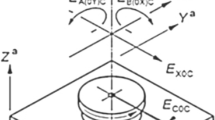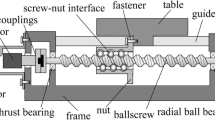Abstract
In the 1990’s enhanced capabilities of parallel kinematic machine tools (PKM) regarding stiffness, motion accuracy and dynamics have been announced generously. Extensive research and development has been done in this area to date. Regarding this, the application range of PKMs is still small. Looking for reasons often yields inadequate motion accuracy as well as insufficient workspace. In either case the passive joints of the kinematic chains pose essential weak points. This article is about eccentric universal joints as an alternative approach that can avoid drawbacks of conventional universal joints and finally enhance the application range of PKMs. However, one of the consequences is a more complex and no longer unique kinematic transformation. This is significant in a control context, where iterative calculations should be avoided when possible due to real-time demands and the uniqueness of the solution has to be guaranteed in any case. Though the general inverse kinematic problem of industrial robots is identical, no generic closed-form (non-iterative) solution is known so far. But often closed-form as well as unique solutions are possible yet by considering particular features of the kinematic chain. In this paper after an introduction types of joint eccentricity are discussed and corresponding inverse kinematic transformations are derived with control purposes in mind.







Similar content being viewed by others
References
Neugebauer R (ed) (2004) Parallel kinematic machines in research and practice. Proc 4th Chemnitz Parallel Kinematics Seminar PKS 2004, April 20–21, 2004, Reports from the IWU vol. 24, Verlag Wissenschaftliche Scripten, Zwickau
Neugebauer R (ed) (2006) Parallel kinematic machines in research and practice. Proc. 5th Chemnitz Parallel Kinematics Seminar PKS 2006, April 25–26, 2006, Reports from the IWU vol. 33, Verlag Wissenschaftliche Scripten, Zwickau
Heisel U, Weule H Hrsg (2008) Fertigungsmaschinen mit Parallelkinematiken—Forschung in Deutschland. Shaker Verlag, Aachen
Tran TL (2000) Allgemeine Transformation für Maschinen mit Parallelkinematiken. PhD thesis, University of Stuttgart
Schaeffler Technologies GmbH & Co. KG (Edt) (2004) Komponenten für parallele Kinematiken. Marktinformation MAI66
Otremba R (2004) Systematische Entwicklung von Gelenken für Parallelroboter. PhD thesis, Technische Universität Braunschweig
Fedotov S (2005) Untersuchung von Parallelmechanismen hinsichtlich deren Eignung als Geräteschnittstelle von Traktoren. PhD thesis, TU Dresden
Rudik R (2006) Untersuchungen zur Entwicklung der Steuerung eines neuartigen Traktorhubwerkes auf der Basis der Hexapod-Mechanismen. PhD thesis, TU Dresden
Großmann K, Kauschinger B, Riedel M (2012) Exzentrische Gelenke für parallelkinematische Werkzeugmaschinen. Zeitschrift für wirtschaftlichen Fabrikbetrieb ZwF 107(1-2):25–32
Kauschinger B (2006) Verbesserung der Bewegungsgenauigkeit an einem Hexapod einfacher Bauart. PhD thesis, TU Dresden
Li H (1990) Ein Verfahren zur vollständigen Lösung der Rückwärtstransformation für Industrieroboter mit allgemeiner Geometrie. PhD thesis, Universität Duisburg
Eppinger M, Kreuzer E (1989) Systematischer Vergleich von Verfahren zur Rückwärtstransformation bei Industrierobotern. Robotersysteme 5:S.219–S.228
Masory O, Wang J, Zhuang H (1996) Kinematic modeling and calibration of a Steward platform. Int J Adv Robot 11(5):519–539
Daney D (2003) Kinematic calibration of the Gough Platform. Robotica 21:677–690
Legnani G, Tosi D, Adamini R, Fassi I (2006) Calibration of parallel kinematic machines: theory and applications. In: Low KH (eds) Industrial robotics: programming, simulation and application, ARS Publication Co., Germany
Großmann K, Möbius V (2000) Hexapod für Handling. Zwischen Roboter und Werkzeugmaschine. Zeitschrift für wirtschaftlichen Fabrikbetrieb ZwF 95(6):290–293
Acknowledgments
We’ld like to thank the German Research Foundation (DFG) for their kind support within the project ”Fundamentals for the application of eccentric joints in parallel kinematic machine tools” (GR 1458-34/1).
Author information
Authors and Affiliations
Corresponding author
Rights and permissions
About this article
Cite this article
Großmann, K., Kauschinger, B. Eccentric universal joints for parallel kinematic machine tools: variants and kinematic transformations. Prod. Eng. Res. Devel. 6, 521–529 (2012). https://doi.org/10.1007/s11740-012-0405-7
Received:
Accepted:
Published:
Issue Date:
DOI: https://doi.org/10.1007/s11740-012-0405-7




